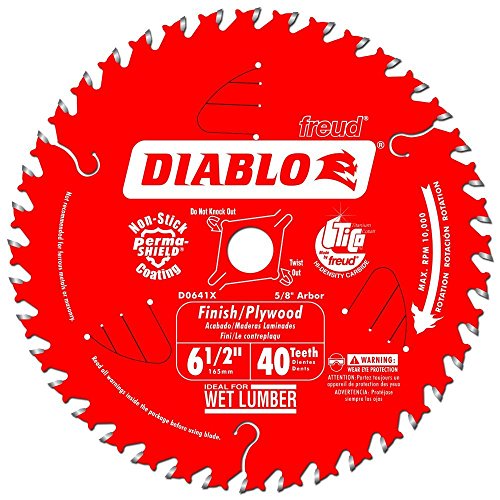Hi my friends! I’m Maria Rodriguez from best2buy.reviews. Today, I'm excited to share some tips for choosing Circular Saw Blades to help you make a confident choice. Check it now!
- 1. Circular Saw Blades
- 1.1. Blade Types:
- 1.2. Material Compatibility:
- 1.3. Blade Size:
- 1.4. Tooth Configuration:
- 1.5. Tooth Count:
- 1.6. Arbor Size:
- 1.7. Blade Coatings:
- 1.8. Safety Precautions:
- 1.9. Maintenance:
- 2. Benefits of choosing right Circular Saw Blades
- 2.1. Improved Cutting Performance
- 2.2. Enhanced Safety
- 2.3. Extended Blade Life
- 2.4. Efficiency and Productivity
- 2.5. Cost Savings
- 2.6. Versatility
- 2.7. Better Finish
- 2.8. Reduced Strain on the Saw
- 2.9. Less Material Waste
- 2.10. Professional Results
- 2.11. Minimized Tear-Out
- 3. How to choose Circular Saw Blades?
- 3.1. Identify the Material to Be Cut:
- 3.2. Determine the Type of Cut:
- 3.3. Consider Blade Diameter:
- 3.4. Choose the Right Tooth Configuration:
- 3.4.1. For wood:
- 3.4.2. For metal:
- 3.5. Select the Right Tooth Count:
- 3.6. Consider Blade Coatings and Features:
- 3.7. Check Arbor Size:
- 3.8. Determine Blade Speed Rating:
- 3.9. Read Manufacturer Recommendations:
- 3.10. Consider Specialty Blades:
- 3.11. Budget and Quality:
- 3.12. Safety First:
- 4. In conclusion
Circular Saw Blades
Circular saw blades are essential tools used in woodworking, construction, and various other applications to cut through a wide range of materials, including wood, metal, plastic, and masonry. These blades have a circular shape with teeth along the edge designed to remove material as the blade rotates. Here are some key aspects of circular saw blades:
Blade Types:
- Rip Blades: Designed for making long, straight cuts along the grain of wood. They have fewer teeth with larger gullets for efficient material removal.
- Crosscut Blades: Suitable for making clean, perpendicular cuts across the grain of wood. They have more teeth with smaller gullets for a smoother finish.
- Combination Blades: These blades are versatile and can handle both ripping and crosscutting tasks.

Material Compatibility:
- Wood Blades: Designed specifically for cutting wood. They have different tooth configurations depending on whether you need to rip or crosscut.
- Metal Blades: Used for cutting various types of metal. They typically have smaller, finer teeth with specialized coatings to prevent overheating.
Blade Size:
- Circular saw blades come in various sizes, usually ranging from 4 inches to 12 inches in diameter. The size you choose depends on your saw's capacity and the depth of cut you require.
Tooth Configuration:
Blades have different tooth configurations, including:
- Alternate Top Bevel (ATB): Suitable for clean crosscuts in wood.
- Flat Top (FT): Used for ripping wood.
- Triple Chip Grind (TCG): Ideal for cutting hard materials like laminates and metal.
- High Alternate Top Bevel (Hi-ATB): Provides ultra-smooth cuts for fine woodworking.
Tooth Count:
- The number of teeth on the blade affects the quality of the cut. Blades with more teeth tend to produce smoother finishes, while those with fewer teeth are better for faster material removal.
Arbor Size:
- Circular saw blades have a central hole (arbor) that fits onto the saw's arbor shaft. It's crucial to ensure the blade's arbor size matches your saw's arbor size.
Blade Coatings:
- Some blades feature special coatings, such as carbide tips or anti-friction coatings, to increase durability and reduce heat buildup.
Safety Precautions:
When using circular saw blades, always wear appropriate safety gear, including safety glasses and hearing protection.
- Ensure the blade is properly installed and tightened on the saw.
- Keep hands and body parts away from the path of the blade while cutting.
- Follow the manufacturer's guidelines for your specific saw and blade.
Maintenance:
- Regularly inspect your circular saw blades for damage or dullness.
- Sharpen or replace blades as needed to maintain cutting efficiency and safety.
Choosing the right circular saw blade for your project involves considering the type of material you're cutting, the desired cut quality, and the specific requirements of your saw. Using the appropriate blade will help you achieve accurate and clean cuts while prolonging the life of your saw and blade.
Benefits of choosing right Circular Saw Blades
Choosing the right circular saw blade for your specific woodworking or cutting task offers several significant benefits:
Improved Cutting Performance
The most obvious benefit is that the right blade is optimized for the material you're cutting. This results in smoother, cleaner, and more efficient cuts. For example, using a crosscut blade for cutting across wood grain or a metal-cutting blade for metal ensures the best performance.
Enhanced Safety
Proper blade selection contributes to safer operation. When you use the right blade for the job, you reduce the risk of blade binding, kickback, or overheating. This, in turn, reduces the likelihood of accidents and injuries.
Extended Blade Life
Matching the blade to the material and the type of cut you're making reduces wear and tear. Blades that are well-suited to the task are less likely to become dull prematurely. This not only saves money on replacement blades but also ensures consistent cutting quality over time.
Efficiency and Productivity
The right blade increases your efficiency by minimizing the need for rework or adjustments. You'll be able to complete your cutting tasks more quickly and with fewer hassles.
Cost Savings
While high-quality circular saw blades can be an investment, they are cost-effective in the long run. You won't need to replace them as often, and they reduce material waste by delivering precise cuts.
Versatility
If you choose a versatile combination blade, you'll have the flexibility to handle various cutting tasks with a single blade. This versatility can be especially helpful if you frequently work with different materials.
Better Finish
When you use the right blade for the job, you're more likely to achieve a smoother and cleaner finish on your cuts. This is essential for projects where aesthetics matter, such as fine woodworking.
Reduced Strain on the Saw
Using the appropriate blade for the material reduces the strain on your circular saw. This can extend the lifespan of your saw and reduce the need for repairs or replacements.
Less Material Waste
The right blade minimizes material waste by making precise cuts. This is crucial when working with expensive or limited materials.
Professional Results
Whether you're a professional woodworker or a DIY enthusiast, choosing the right circular saw blade helps you achieve professional-level results. Your projects will look and perform better.
Minimized Tear-Out
Proper blade selection can reduce or eliminate tear-out, which is the splintering or chipping of the material's surface when cut. This is particularly important when working with hardwoods or materials with delicate surfaces.
In summary, selecting the appropriate circular saw blade is a crucial aspect of achieving high-quality results, ensuring safety, and maximizing the efficiency and longevity of your tools. It's worth investing time in choosing the right blade for each cutting task to reap these benefits.
How to choose Circular Saw Blades?
To choose right Circular Saw blades, check our recommendation as below:
Identify the Material to Be Cut:
Determine the type of material you'll be cutting. Common materials include wood, metal, plastic, laminate, and masonry.
Determine the Type of Cut:
Decide whether you need to make crosscuts (across the grain), rip cuts (along the grain), or specialty cuts like bevel cuts or dado cuts. Different blades are designed for different types of cuts.
Consider Blade Diameter:
Check your circular saw's specifications for the maximum blade diameter it can accommodate. Select a blade size that fits your saw and meets the depth of cut requirements for your project.
Choose the Right Tooth Configuration:
For wood:
- Crosscuts (across the grain): Choose a blade with a high tooth count and an Alternate Top Bevel (ATB) or High Alternate Top Bevel (Hi-ATB) tooth configuration for clean cuts.
- Rip cuts (along the grain): Opt for a blade with fewer teeth and a Flat Top (FT) tooth configuration for efficient material removal.
For metal:
- Use a blade specifically designed for cutting metal. Metal-cutting blades have smaller, finer teeth and may have coatings to reduce heat buildup.
Select the Right Tooth Count:
Blades with more teeth provide smoother finishes but may cut more slowly. Blades with fewer teeth cut faster but may leave a rougher surface. Choose the tooth count based on your desired finish and the material's thickness.
Consider Blade Coatings and Features:
Some blades come with special coatings, such as carbide tips or anti-friction coatings, to improve durability and reduce heat buildup. Consider these features for longer blade life and smoother cuts.
Check Arbor Size:
Ensure that the blade's arbor size (the hole in the center of the blade) matches the arbor size of your circular saw. The most common sizes are 5/8 inches and 1 inch.
Determine Blade Speed Rating:
Check the blade's speed rating, which should match or exceed the maximum speed of your circular saw. Running a blade at a speed higher than it's rated for can be dangerous.
Read Manufacturer Recommendations:
Consult the manufacturer's guidelines and recommendations for your specific circular saw and blade type. These guidelines will help you make an informed choice.
Consider Specialty Blades:
If you have unique cutting requirements, such as cutting laminates, melamine, or non-ferrous metals, consider specialty blades designed for those materials.
Budget and Quality:
While it's tempting to choose the least expensive blade, investing in a quality blade suited for your needs will yield better results, reduce frustration, and last longer.
Safety First:
Always prioritize safety when selecting a circular saw blade. Ensure the blade is compatible with your saw and the material, and follow all safety precautions and guidelines while using it.
By carefully considering these factors and matching the blade to your specific cutting task, you'll improve the quality of your work, extend the life of your blades and saw, and enhance your overall safety when operating a circular saw.
In conclusion
To buy circular saw blades, you can buy in store but if you don’t have time, I recommend you to buy in Amazon. That platform offer you with various products and wide range price together promotion. Buy in Amazon, you will easily find your need. To make you easily choose circular saw blades in Amazon, we selected top best seller circular saw blades in our website. Read carefully and Enjoy!
I’m Maria Rodriguez - editor from best2buy.reviews. I’m very happy to respose your question.If you need our support, don’t hesitate, Kindly comment below. I’m always available to response you.











